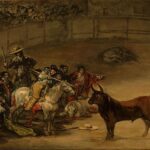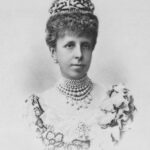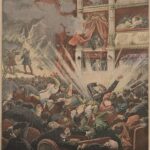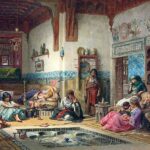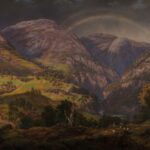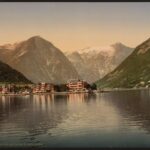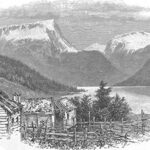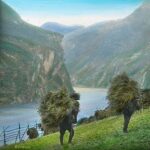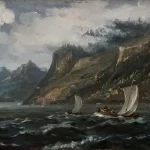Caroline Earle White
Caroline Earle is most widely known for her work in early animal rights advocacy, and specifically the founding of the women’s branch of the Pennsylvania Society for the Prevention of Cruelty to Animals in 1869. In addition, she also founded the American Anti-Vivisection Society in 1883, which opposed medical experimentation using animals. After becoming a member organization of the National Council of Women in 1894, AAVS became more closely connected to the broader women’s right’s movement but did not go so far as explicitly supporting suffrage. Beyond advocacy, White also had a successful writing career, publishing fiction such as the romance Loves in the Tropics and the short story collection Modern Agrippa and Patience Barker.

“Everything in Norway is on so grand a scale that the productions of the camera, fine as many of them are, fall far short of the reality, and consequently we feel that we should prefer to have no representation of beauties that would only be belittled thereby, but trust to our memory to preserve unimpaired the recollection of all the grandeurs we have witnessed.” (p.96) (Hellesilt, Norway)
Image: “View of Stalheim”, Johan Christian Dahl, 1842
Themes
The theme of “Customs and Morals” include anything from cultural practices and beliefs to the traditions, religion, and cuisine of the people of Spain and Norway.
“It is almost inconceivable that any amusement involving such horrible cruelty [such as bullfighting], should be so popular with a people who seem, as a general thing, kind and gentle, but so it is,” (p.47).
“The food and cooking in most of [the hotels] are poor, according to American ideas. We should sometimes have found it difficult to take enough to satisfy our hunger, had it not been for the oranges which were always on the table at the dejeuner and dinner, and which were, as a general thing, delicious,” (p.63).
“This beautiful water ; there is not a suspicion of mud or dirt connected with it and in its purity and loveliness it seems to me emblematic of the character of the people which strikes us as abounding in charming qualities. They have not yet been contaminated by coming into contact with the outside world, but whether this will long be the case, with such an influx of tourists, as is now taking place, appears rather doubtful.” (p. 70-71) (Balholm, Noway)
“The married women wear a peculiar white cap or head-dress, made with a border, into which a stiffener is introduced so as to make it stand out all around the face…” (p.78) (Balholm, Norway)
“We have constantly the finest fish—salmon and trout as well as other varieties —in great abundance, a moderate supply of meat, that placed before us being sometimes beef, sometimes reindeer or kid, as the case may be, but no vegetables of any account beside potatoes, and very little fruit.” (p.83) (Balholm, Norway)
“Some of the customs of the people are peculiar, one of the most so, that of shaking hands with a person who gives them anything or does them a favor”. (p.89) (Hellesilt, Norway)
The farmers seem to be a contented sort of people; indeed, an absence of greed appears a characteristic of the nation. (p.99) (Molde, Romsdal, Norway)
The quotes that fit in the theme of “nature” include descriptions of the physical, natural, environment of each respective location. Caroline Earl White spends much time in her narrative painting a detailed picture of the natural landscape of the locations that she visits.
“After leaving the jail [in Tangier, Morrocco] we rode onto a hill which gave us a fine view of the city, and then descended to the seashore, where the setting sun gilding the tops of some of the hills on the opposite side of the bay, and leaving others in shadow while it cast a rosy light on the softly lapping waves of the Mediterranean, made a picture which filled us with delight,” (pp.37-38).
“The water below was of a deep blue, and of the extreme clearness which characterizes most of the lakes and mountain streams in Norway. I cannot imagine anything more pellucid than this beautiful water ; there is not a suspicion of mud or dirt connected with it…” (p.70) (Balholm, Norway)
As a figure who was heavily involved in Woman’s Rights in the United States, Caroline Earl White provides unique insight into the gender roles of the women in Spain and Norway
“The Spanish women generally, that we have seen, have not impressed us in the way of looks. They have very little expression or play of feature, and that little they lessen by covering their faces with powder,” (p.55).
“We went, one day, to the great tobacco factory of Seville. It gives occupation to six thousand women and girls, although some of them, we are told, are very poorly paid. Many of them are mothers, and take their babies or young children with them to the factory,”(p.54).
“Only the ladies of our party were allowed to enter [the harem]. We found five or six inmates, one being evidently servant. Of the others, the eldest was much the handsomest, but all had very fine eyes. They were dressed the Eastern costume, with sashes very low down around their waists, and some soft white stuff around their heads. Their apartments consisted of several rooms around an open court-yard, all with beautifully tessellated floors in different colored stone,” (p.35).
It’s interesting to see how Caroline Earl White, who is from one of the most developed and wealthy countries of the era, views the technology and innovation that Spain and Norway utilize.
“Spanish trains go very slowly, and, when they arrive at a place, do not seem to be in any hurry to leave…The mails are also distributed at each station and we were much amused, on one occasion, while the train appeared to be waiting an indefinite time with no one getting off or getting on, at seeing one of the officials reading aloud a letter to a peasant, who,
as we supposed, had just received and was unable to read or write. These immensely long stops at some of the trifling wayside stations, we have never been able to comprehend,” (pp.9-10).
“Upon leaving Odde, we drove to Vossewangen, where we took the train for Bergen. This is the only railroad in the western part of Norway, and is a model of engineering skill. It is only seventy miles long, but cost an immense amount of money on account of the difficulty of the mountains nearly every foot of the way. Short as it is it, it had 55 tunnels. It took us about three hours to reach Bergen,” (p. 79).
“Another thing we often see, and which has interested us very much, is the number of wires reaching from the top of a high cliff or mountain and fastened by a windlass in the valley below near farm-houses, so that grass or hay can be sent down on them, as well as milk, fire-wood, and sometimes other articles.” (p.97-98) (Molde, Romsdal, Norway)
"Only the ladies of our party were allowed to enter here...They were dressed the Eastern costume, with sashes very low down around their waists, and some soft white stuff around their heads. Their apartments consisted of several rooms around an open court-yard, all with beautifully tessellated floors in different colored stone."
Image: “La Conteuse Nubienne au Harem” by Frederick Arthur Bridgman (1875)
Places Visited
Upon entering the countries Barcelona, White links its fast-paced business oriented demeanor to American culture. Indeed, in 1895, the year of this text’s publishings, the US was in the midst of a large urban-based industrial revolution.
[Barcelona] is the most prosperous city of the kingdom, and most resembles one of our American towns in the bustle and air of business which pervade the community,” (p.7).
To White, Tangier is quite simply a shock, holding completely different qualities than that of America. However, that uniqueness is what gives the location its value.
“Every American should come to Tangier if he wishes to see the exact opposite of everything that he has ever beheld or known all his life before…There no road either or around the city, consequently such thing as carriage unknown…Through these narrow streets, particularly the principal one of the town, pours a motley assemblage of Moors in coarse, light cotton garments, with their faces covered up excepting the eyes, negroes, Jews, Europeans, and Americans, horses, mules, donkeys, camels, and dogs, all mixed up in inextricable confusion,” (pp.30-31).
“The poverty and dirt and squalor are indescribable, and yet, in spite of it all, there is a picturesqueness and air of romance and a glamour that can be found nowhere but in the East,” (p.37).
The Corpus Christi festival held in Seville is quite exciting to White and her lively descriptions of this distinctive occasion would likely be of strong interest to her less well-traveled American audience.
“This is one of the most interesting cities of Spain, and we have found so much to see…we have been told that nowhere in Spain, indeed, nowhere in the whole world, is Corpus Christi celebrated as it is here. There is a wonderfully curious ceremony, which is to be seen nowhere but here—a dance by the young men and boys of the choir, which is to take place after mass, and when this is over there is to be a grand procession through the principal streets of the city,” (pp.44-45).
Unfortunately, Madrid, White’s final Spanish stop and the nation’s capital, is not particularly exciting to her. These descriptions of somewhat disappointing experiences give a sense of realism to her otherwise animated narrative.
“All the Spanish cities we had hitherto seen had been more or less of the same type…but we found, to our surprise, Madrid entirely different. The streets are as remarkably wide as those of the other cities are narrow… it is very handsome, but did not interest us greatly,” (pp.58-59).
Upon arriving at the first location of the Norway segment of her journey, Caroline Earl White is captivated by the natural beauty of Balholm. She goes into lengthy detail describing the landscape around her, such as the pools of “emerald green color” and a waterfall so strong that “for a quarter mile [she] could see nothing but spray and foam”. (p. 70)
In this leg of her journey, Earl White is able to continue touring the natural wonders of Noway, visiting a well-known lake called Bredheim’s vaud, which, according to Earl White, had a light green color that was “different from anything we had ever seen before in any part of the world.” (p.93) White ends her entry by stating “Everything in Norway is on so grand a scale that the productions of the camera, fine as many of them are, fall far short of the reality, and consequently we feel that we should prefer to have no representation of beauties that would only be belittled thereby, but trust to our memory to preserve unimpaired the recollection of all the grandeurs we have witnessed.” (p.96)
Caroline Earl White begins documenting her Molde leg of her journey by describing the tradition of hay-making, as well as her fascination with a system of transportation that their local farmers use to send items down steep mountains. She also managed to tour some of the local sights neighboring Molde as well. In Romsdal, a neighboring district to Molde, Earl White visited these “immense masses of rock in such numbers and confusion that they seemed as if they might have been playthings thrown about by the Titans of old.” (108) Apparently, these rocks were once part of the mountain that had broken off and fallen into the valley below.
Bergen is the last stop on Caroline Earl White’s Norway trip. To get to Bergen from Molde, she took a beautiful boat ride along the coast, sailing past the numerous islands scattered around the coast of Norway. Earl White’s own descriptions capture it best: “[The islands] looked most lovely in the evening light cast by the setting sun, which colored them with a purple sheen and transfigured the whole scene.” (p.117) Once she got to land, she visited the Hanseatic Museum, which included detailed artifacts and information about the Hanseatic merchants that came to Bergen in the 13th century to exchange grain for stockfish from Northern Norway. Caroline ends her journey by “looking back upon our sojourn in Norway with much pleasure, and bidding good-by with regret to a country so full of natural beauty and a people so gifted with noble and attractive traits of character”. (p.117)
"It is almost inconceivable that any amusement involving such horrible cruelty should be so popular with people who seem, as a general thing, kind and gentle.”
Image: “Suerta de Vargas” by Francisco de Goya (1824)
Secondary Sources
- Sukko Kim, Division of labor and the rise of cities: evidence from US industrialization, 1850–1880
- Miguel-Anxo Murado, When Terror Came to Barcelona
- John Lawrence Tone, War and genocide in Cuba, 1895-1898
- Cynthia Enloe, Bananas, beaches & bases : making feminist sense of international politics
- Emily M. Weeks, Multiple Wives, Multiple Pleasures: Representing the Harem, 1800-1875
- Ilene Susan Fort, Frederick Arthur Bridgman and the American fascination with the exotic Near East. (Volumes I and II)
- Frank I. Heckes, Goya's "Tauromaquia" A Criticism of Bullfighting?
